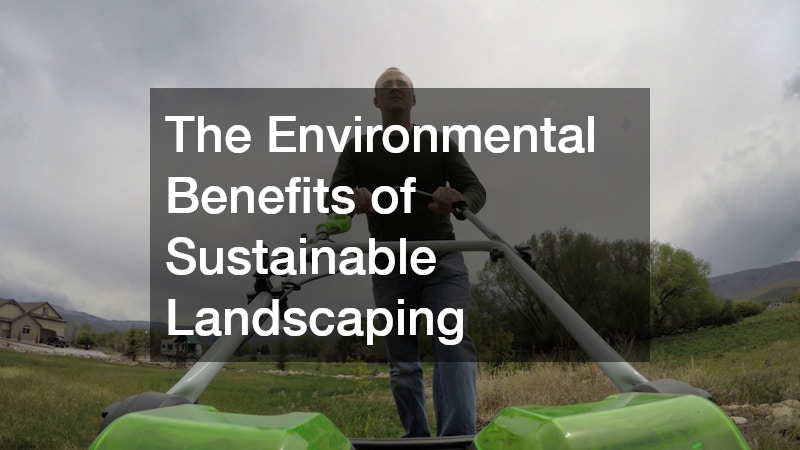Landscaping is more than just a way to improve the look of your outdoor space — when done sustainably, it can also offer real benefits for the environment. As more homeowners become aware of climate change and resource conservation, the shift toward eco-friendly landscaping practices is growing stronger.
Sustainable landscaping takes into account local ecosystems, water usage and long-term environmental impact, all while creating a beautiful and functional outdoor area.
Let’s explore how this approach supports the environment and why it’s worth considering for your home or property.
Reducing Water Waste
One of the most immediate advantages of sustainable landscaping is its ability to reduce water use. Traditional gardens often rely on water-thirsty plants and lawn areas that need frequent irrigation. In contrast, a sustainable landscape design uses drought-resistant plants that are native to the region. These plants are naturally adapted to the local climate, meaning they can thrive with minimal watering once established.
Using mulch around garden beds helps retain soil moisture, which further reduces the need for constant watering. Efficient irrigation systems, such as drip lines or smart timers, also play a key role in conserving water. By designing your garden with water use in mind, you’re actively contributing to a more responsible and environmentally conscious approach to landscaping.
Supporting Local Biodiversity
Sustainable landscaping encourages the use of native plants and trees, which provide food and shelter for local wildlife. This includes birds, insects and small animals that are often displaced by urban development. By choosing the right plants, your garden can become a mini habitat that supports pollinators like bees and butterflies, both of which play a critical role in natural ecosystems and food production.
Avoiding harsh chemicals in your landscaping routine is also essential. Pesticides and synthetic fertilisers can pollute local waterways and harm beneficial organisms. Composting and using organic mulch or natural fertilisers can keep your soil healthy without introducing harmful substances into the environment.
Lowering Your Carbon Footprint
The way we maintain our outdoor spaces can have a significant impact on greenhouse gas emissions. Petrol-powered lawnmowers, leaf blowers and other equipment release carbon dioxide and contribute to air pollution. By reducing the size of traditional lawns and using manual or electric tools, you can help cut down on your property’s carbon output.
Incorporating trees and other large plants into your landscaping also helps absorb carbon dioxide from the atmosphere. Trees provide shade, improve air quality and even reduce energy use inside the home by lowering surrounding temperatures during summer. The benefits go beyond appearance — sustainable landscaping contributes to healthier air and cooler microclimates around your home.
Preventing Soil Erosion and Runoff
Sustainable landscaping practices protect the soil by encouraging ground cover and preventing erosion. Exposed soil can easily wash away during heavy rain, leading to sediment buildup in stormwater drains and waterways. Ground covers such as native grasses, low shrubs and mulch help hold soil in place, reducing the risk of erosion and nutrient loss.
Permeable surfaces, such as gravel paths or stone pavers, allow rainwater to soak into the ground instead of running off into drains. This helps reduce flooding and improves groundwater recharge, making your garden more self-sustaining in the long term.
Creating Healthier Outdoor Spaces
Sustainable landscaping doesn’t just help the planet — it also creates a healthier space for people. With reduced chemical use, better air quality and more shade, your outdoor area becomes a place that’s comfortable and safe for your family. Children and pets can play freely without the risk of chemical exposure or overheating on a hot summer day.
Landscaping that prioritises sustainability often incorporates elements like vegetable gardens or compost bins. These additions can encourage healthy eating and waste reduction, further promoting a low-impact lifestyle. Many people also find that spending time in a well-designed garden improves their mental health and overall sense of wellbeing.
Long-Term Cost Savings
While sustainable landscaping may require an upfront investment in native plants, mulch or water-saving irrigation, the long-term savings are considerable. Lower water bills, reduced maintenance needs and fewer chemical products all add up over time. Native plants are generally hardier and require less care, which means less time and money spent on replacements or repairs.
For property owners looking to future-proof their home or increase resale value, a sustainable garden can be a smart move. It shows that the property is eco-conscious, low maintenance and in tune with modern environmental values.
Sustainable landscaping is a practical and rewarding way to care for both your property and the planet. By using less water, reducing emissions and supporting local ecosystems, it’s possible to create an outdoor space that’s as beneficial as it is beautiful. As Australians continue to embrace environmentally responsible living, this approach to gardening offers a clear path forward — one that’s rooted in respect for nature and a vision of long-term sustainability.
Whether you’re starting fresh or upgrading an existing garden, consider making landscaping choices that help protect the environment for generations to come.

